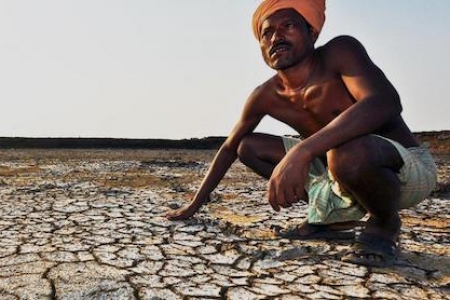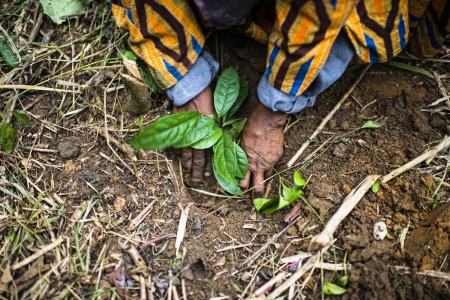In the context of WLE, this activity is aligned with the resilience work of the ESR core theme. The work specifically focuses on how biodiversity can be managed in agricultural systems to buffer unpredictable environmental change (Nepal), and how biodiversity management can be used to enhance delivery of key ecosystem services while still providing identifiable livelihood benefits (Sri Lanka). Environmental change provides a specific context where adaptability and resilience based strategies have increased importance to rural communities. Temperatures are steadily increasing and weather patterns are becoming more unpredictable and extreme with prolonged dry or wet spells and very strong storm events in the high mountain agricultural environments of Nepal and humid subtropic areas of Sri Lanka. Changes in water availability and quality, in soil quality, nutrient availability, frequency and intensity of pest and disease problems have all been identified at the selected activity sites and linked to land and ecosystem service degradation. This activity addresses agrobiodiversity’s specific contribution to resilience (Nepal), and ecosystem services provisioning (Sri Lanka). In collaboration with communities and ministries in both countries, the activity seeks ways in which these contributions can be secured and enhanced. The underpinning hypothesis of the activity is that farmers benefit from increased availability of locally adapted materials, together with adapted ecosystem management practices, through (i) improved provision of ecosystem services (e.g. target ecosystem service areas include pest and disease regulation, soil quality, water availability and quality, and pollination); (ii) improving adaptability and resilience to environmental change; and, (iii) improving livelihood options through diversification. The components of this hypothesis are being tested through a series of integrated activities using approaches that ensure full farmer and community involvement and control over key decisions. In Nepal, the primary focus is on diversity’s contribution to pest and disease regulation and environmental change. Species selection and varietal plasticity offer an adaptation and resilience option that may be of considerable significance. In the resilience work, we focus specifically on the response traits of agricultural biodiversity, their response to environmental change. Species selection and varietal plasticity will be assessed in Nepal looking at the overall performance in terms of yield and resistance to biotic and abiotic stress over time. Landscape approaches are critical here as they allow mapping species with specific traits and the option of mobilizing these species/varieties in response to improving cropping system stability in the face of increased environmental variability. The species/varieties identified will be made available to farmers who will have the option of adopting them depending on local conditions. In Sri Lanka an integrated approach is being adopted to investigate the ways in which management and use of agrobiodiversity (associated and selected) can be integrated with sustainable ecological agricultural management practices to provide optimum (win-win) pathways to improved production sustainability, and overall productivity and contributions farmer livelihoods. In contrast to the Nepal work, here the focus is on species effect traits – that is the effect they have on ecosystem service provisioning rather than their response to environmental change. The activities are being undertaken through GEF supported projects in Nepal and Sri Lanka in seven sites (4 and 3 respectively) selected to provide a set of contrasting situations in which high levels of diversity have traditionally played a key role in system management and supporting livelihoods but which inappropriate development options, environmental change, conflicts over land management and other factors are compromising system adaptability and resilience and reducing livelihood options. The GEF framework provides an appropriate framework for assessing and monitoring outcomes that support the investigative action- research framework of the activity and is aligned with national partner commitments to reaching the Aichi targets (Convention on Biological Diversity). A common set of actions has been identified which have individually been successful in other contexts but have not previously been brought together especially with respect to agrobiodiversity’s use within a landscape management framework for ecosystem and resilience. The activity will result in: additional crop species and varieties and livestock breeds adapted to changing environments accompanied with adapted production practices within the target production landscapes (sites); adoption of sustainable management practices and improved ecosystem service provision; improved livelihood options through diversification and development of diversity rich marketing; improved capacity at community, extension service and NARs levels; and, a more conducive policy environment with strengthened local institutions regarding the use of agricultural biodiversity for ecosystem service provisioning and resilience. Baseline and end of activity studies of the different agro-ecosystems provide the necessary information for evaluating results of activities in terms of (a) diversity, (b) soil, water and related ecosystem properties, (c) pollination and pest and disease regulation, (d) livelihoods. Resilience is assessed using social-ecological resilience indicators and other available measures and adaptability strategies using a set of indicators developed within the framework of the national adaptation plan and strategy developed in Sri Lanka and Nepal. An institutional framework for mainstreaming agrobiodiversity conservation and use will be developed in both countries, creating a more favourable policy environment and developing a knowledge framework to ensure that agricultural biodiversity based approaches are a recognized part of national agricultural development and research programmes. The work includes identification of policies, laws and regulations that constrain diversity’s maintenance and use or ecosystem service options, engaging relevant groups at all levels (from community to national) in a series of activities that can support institutional strengthening and policy development, reinforcing participation in local and national decision making fora such as National Agrobiodiversity Committee, National Seed Board, and civil society networks, and the development in Sri Lanka of a National Agrobiodiversity Strategy. We accomplish this by engaging key stakeholders in decision-making teams and by organizing activities (e.g. travelling seminars) to dialogue with, and increase awareness of policy makers. A strong capacity development set of actions will underpin these activities. Key leverage points have been identified as variety registration/seed certification and supply procedures and practices, policies surrounding the supply of agricultural inputs and, in Sri Lanka such positive developments as the establishment of the national Home Garden Support Programme. A specific target that we have identified is the integration of agro-ecosystem management and diversity perspectives in the developing National Adaptation Strategies developed within the United Nations Framework Convention on Climate Change UNFCCC framework. Project activities envisage active participation of farmers and key stakeholders, in such way that full understanding of the value of diversity is reached at different levels (farmers, famer’s associations, local institutions). Participation of policy makers to project activities (e.g. diversity fairs, community seed banks, diversity field schools, diversity field blocks, on-farm trials, etc.) will be facilitated to ensure that contribution of diversity is also understood at in the context of local priorities and national policies as well as to help guide the design of appropriate policy intervention. Major activities carried out in the countries include: Nepal • Multiplication of 125 accessions of Amaranth landraces and the seeds of seven local rice landraces (Sugandha, Barkhe-3 accessions, Salidhan and Hansaraj), were made available to smallholder farmers at the project sites. • Two diversity fairs were conducted (Chippra, Humla district, and Ghanapokhara, Lamjung district) to assess the extent of diversity within the mandate crops in the project districts as well as collect germplasm for the National Genebank. • Naked barley mother trials (8 test varieties and 1 farmer variety) were set up and dispatched along with the activity protocol to four project sites. • Mapping of existing accessions of mandate crops collected in the Genebank from the project districts was completed. Sri Lanka • Agrobiodiversity survey was conducted to identify: (a) traditional and modern cultivars available in each ecosystem, (b) the distribution and abundance of traditional cultivars, (c) farmer requirements of traditional cultivars, (d) possible cultivars for on-farm conservation, (f) cultivars that need to be conserved in ex-situ. • Measures of common crop species and varietal diversity (Simpson, richness, Divergence of traditional varieties of common crops, total number of varieties and % of traditional cultivars) were calculated for each study site. • Surveys on livestock traditional genetic resources (Dept. of Veterinary Basic Sciences, Univ.of Peradeniya) and medicinal plants carried (the Bandranayka Memorial Aurvedic Research Institute (BMARI) have also been carried out. • Assessment of soil (physical and chemical parameters) and water resources (pH, electrical conductivity and turbidity) status started in 2014 and will continue in 2015 (the Natural Resources Management Center, Peradeniya) and associated with system diversity to evaluate the relationship between diversity, management type, and service provision.
menu










